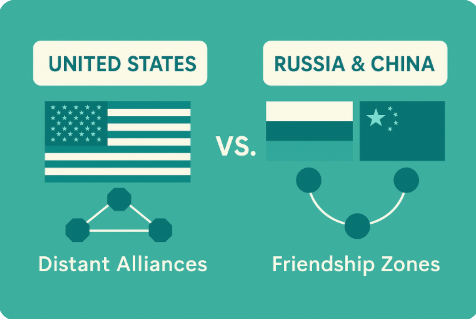1. Introduction
How a state positions its neighbors fundamentally shapes its security and foreign policy order. The United States tends to view its neighbors as potential threats and instead builds robust alliances with distant partners. Russia and China, conversely, strive to incorporate their neighbors into a sphere of influence, often structured as a subordinate order. This divergence reflects geography, historical experience, and national ideology, producing different strengths and weaknesses in global power structures.
2. The U.S. Approach to Neighbors
(1) Historical Background
- Relations with Mexico have long been defined by border disputes, migration, and narcotics issues.
- Canada is a major economic partner, yet trade frictions and energy disputes persist.
(2) Strategic Features
- Neighbors are rarely treated as full allies but rather as security management challenges.
- In contrast, the U.S. builds strong alliances with distant partners such as Europe, Japan, and Australia, based on shared values and security commitments.
(3) Results
- Constant friction with neighbors, but a remarkably stable and durable alliance system abroad.
- Embodies the geopolitical principle: “a distant friend can be more reliable than a close neighbor.”
3. The Russian and Chinese Approach
(1) Historical Background
- Russia’s experience with invasions (Napoleon, Nazi Germany) led to the view that neighbors must serve as buffer zones.
- China, rooted in the tributary system of the “Middle Kingdom,” regards surrounding states as part of its natural hierarchical order, modernized through initiatives such as the Belt and Road or the Shanghai Cooperation Organization.
(2) Strategic Features
- Neighbors are not seen as equal partners but as territories of influence and dependency.
- Publicly framed as “friendship zones,” yet in practice marked by asymmetry and subordination.
(3) Results
- Outwardly wide-ranging cooperation, but internally fragile:
- Central Asian states express unease over Chinese dominance.
- Eastern European countries resist Russian encroachment.
- The “friendship order” often conceals deep contradictions and mistrust.
4. Structural Comparison
| Aspect | United States | Russia & China |
|---|---|---|
| View of Neighbors | Sources of instability, potential threats | Buffer zones, subordinate states |
| Alliance Building | Distant, value-based alliances | Nearby “friendship zones” under influence |
| Stability of Order | Durable, cohesive | Wide but fragile and contradictory |
| Key Examples | NATO, Japan, Australia | Central Asia, Eastern Europe, ASEAN periphery |
5. Implications for Japan
- Japan is geopolitically unique: a distant ally of the U.S. while also a direct neighbor of China and Russia.
- Its optimal strategy is a hybrid model:
- Rely on the U.S. alliance as the security cornerstone.
- Simultaneously manage and stabilize relations with Russia and China to avoid escalation.
6. Conclusion
The U.S. model of treating neighbors as risks has paradoxically enabled it to create stable, long-term alliances abroad. Russia and China’s approach of binding neighbors into spheres of influence yields broad but fragile structures, often plagued by internal contradictions.
Understanding these contrasts is crucial for Japan, which must balance its reliance on U.S. security guarantees with pragmatic management of its immediate neighbors.


